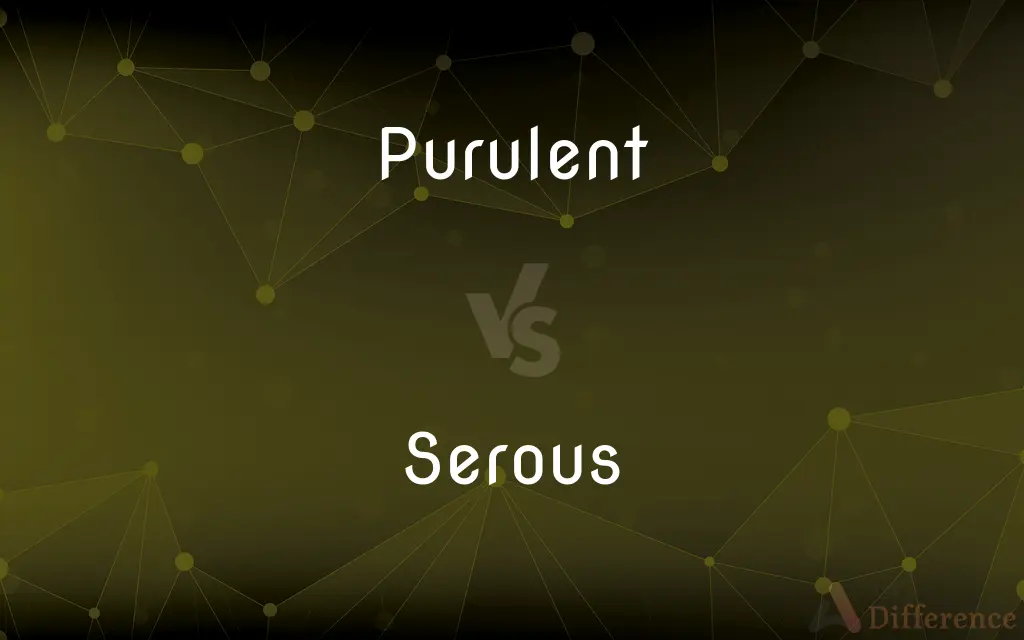Purulent vs. Serous — What's the Difference?
Edited by Tayyaba Rehman — By Urooj Arif — Updated on April 3, 2024
Purulent discharge is thick, often yellow or green, and indicates infection, while serous discharge is clear, thin, and indicates healing.

Difference Between Purulent and Serous
Table of Contents
ADVERTISEMENT
Key Differences
Purulent discharge is characterized by its thick, opaque, and often yellow or green color, suggesting the presence of pus and an ongoing infection. It's typically associated with bacterial infections and can be seen in conditions such as abscesses, boils, and infected wounds. Whereas, serous discharge is clear, watery, and relatively thin. It is typically seen in the early stages of wound healing or in certain chronic conditions. This type of discharge indicates a normal and healthy response to injury or inflammation, with the fluid being comprised mostly of plasma and inflammatory cells that haven't yet been activated by a bacterial infection.
Purulent discharge often requires medical intervention, such as antibiotic treatment, to address the underlying infection and prevent complications. It can be a sign of a more severe infection and may be accompanied by other symptoms such as pain, redness, and swelling. On the other hand, serous discharge usually doesn't require treatment as it's a part of the body's natural healing process. However, if there's an excessive amount of serous fluid or if the discharge is accompanied by signs of infection, medical advice may be needed to rule out complications.
Purulent and serous discharges play different roles in the context of wound healing and infection management. While purulent discharge indicates the need for immediate medical attention to treat an infection, serous discharge is a sign of the body's ongoing healing process.
Comparison Chart
Color
Yellow, green, or brown
Clear or slightly yellow
Consistency
Thick and opaque
Thin and watery
ADVERTISEMENT
Indication
Infection
Healing or mild inflammation
Treatment
Often requires antibiotics or medical intervention
Usually does not require treatment
Associated with
Bacterial infections, abscesses, and infected wounds
Early stages of wound healing, non-infected wounds
Compare with Definitions
Purulent
Containing or consisting of pus.
The wound was discharging a purulent fluid, indicating an infection.
Serous
Pertaining to or resembling serum.
The serous drainage from the wound suggests it's healing properly.
Purulent
Indicative of or resulting from a bacterial infection.
Purulent secretions often require antibiotic therapy.
Serous
Producing a clear, watery fluid.
Serous membranes secrete a fluid that reduces friction.
Purulent
Related to or resembling pus.
Purulent material was found in the abscess cavity.
Serous
Related to serum or serous fluid.
Serous inflammation is usually less severe than purulent.
Purulent
Producing or discharging pus.
The purulent lesion was painful and swollen.
Serous
Indicative of early-stage healing.
The presence of serous discharge is a good sign of wound healing.
Purulent
Associated with pus formation.
Purulent conjunctivitis needs prompt medical attention.
Serous
Associated with mild inflammation.
The serous effusion in his knee was due to mild arthritis.
Purulent
Consisting of, containing, or discharging pus
A purulent discharge
Serous
Containing, secreting, or resembling serum.
Purulent
Containing, discharging, or causing the production of pus
A purulent infection.
Serous
Thin; watery; like serum; as, the serous fluids.
Purulent
(medicine) Consisting of pus.
Serous
Of or producing or containing serum;
A serous exudate
Purulent
Leaking or seeping pus.
Purulent inflammation
Purulent
Consisting of pus, or matter; partaking of the nature of pus; attended with suppuration; as, purulent inflammation.
Purulent
Having undergone infection;
A purulent wound
Common Curiosities
Is it normal to have serous discharge after surgery?
Yes, it's a normal part of the healing process, indicating that the body is responding to the surgical wound.
Should purulent discharge be treated?
Yes, it often requires medical treatment, such as antibiotics, to address the underlying infection.
How can you differentiate between purulent and serous discharge?
Purulent discharge is thick and colored (yellow, green, or brown), while serous discharge is clear and watery.
What does a clear discharge mean?
Clear discharge, or serous discharge, usually indicates healing or mild inflammatory response.
Is serous discharge a sign of infection?
No, serous discharge is typically a sign of healing or mild inflammation, not infection.
What causes purulent discharge?
Purulent discharge is caused by bacterial infections, leading to the accumulation of pus.
Can purulent discharge lead to complications?
If untreated, it can lead to serious complications by spreading the infection.
What should you do if you have purulent discharge?
Seek medical advice for appropriate treatment.
Can both purulent and serous discharges occur at the same site?
Yes, especially in wounds transitioning from an infected state to healing.
How is purulent discharge treated?
Treatment often involves antibiotics and cleaning of the infected area.
What is the role of serous fluid?
Serous fluid helps to reduce friction between tissues and plays a role in wound healing.
Why is it important to monitor the type of wound discharge?
It helps in assessing the wound's healing progress and identifying infections.
Is purulent discharge always a sign of bacterial infection?
While commonly due to bacteria, it can also result from other types of infections.
How long does serous discharge last?
It varies but usually diminishes as the healing process progresses.
Can serous discharge become purulent?
If a wound becomes infected, serous discharge can transition to purulent.
Share Your Discovery

Previous Comparison
Implementation vs. Enforcement
Next Comparison
Passerelle vs. GangwayAuthor Spotlight
Written by
Urooj ArifUrooj is a skilled content writer at Ask Difference, known for her exceptional ability to simplify complex topics into engaging and informative content. With a passion for research and a flair for clear, concise writing, she consistently delivers articles that resonate with our diverse audience.
Edited by
Tayyaba RehmanTayyaba Rehman is a distinguished writer, currently serving as a primary contributor to askdifference.com. As a researcher in semantics and etymology, Tayyaba's passion for the complexity of languages and their distinctions has found a perfect home on the platform. Tayyaba delves into the intricacies of language, distinguishing between commonly confused words and phrases, thereby providing clarity for readers worldwide.














































